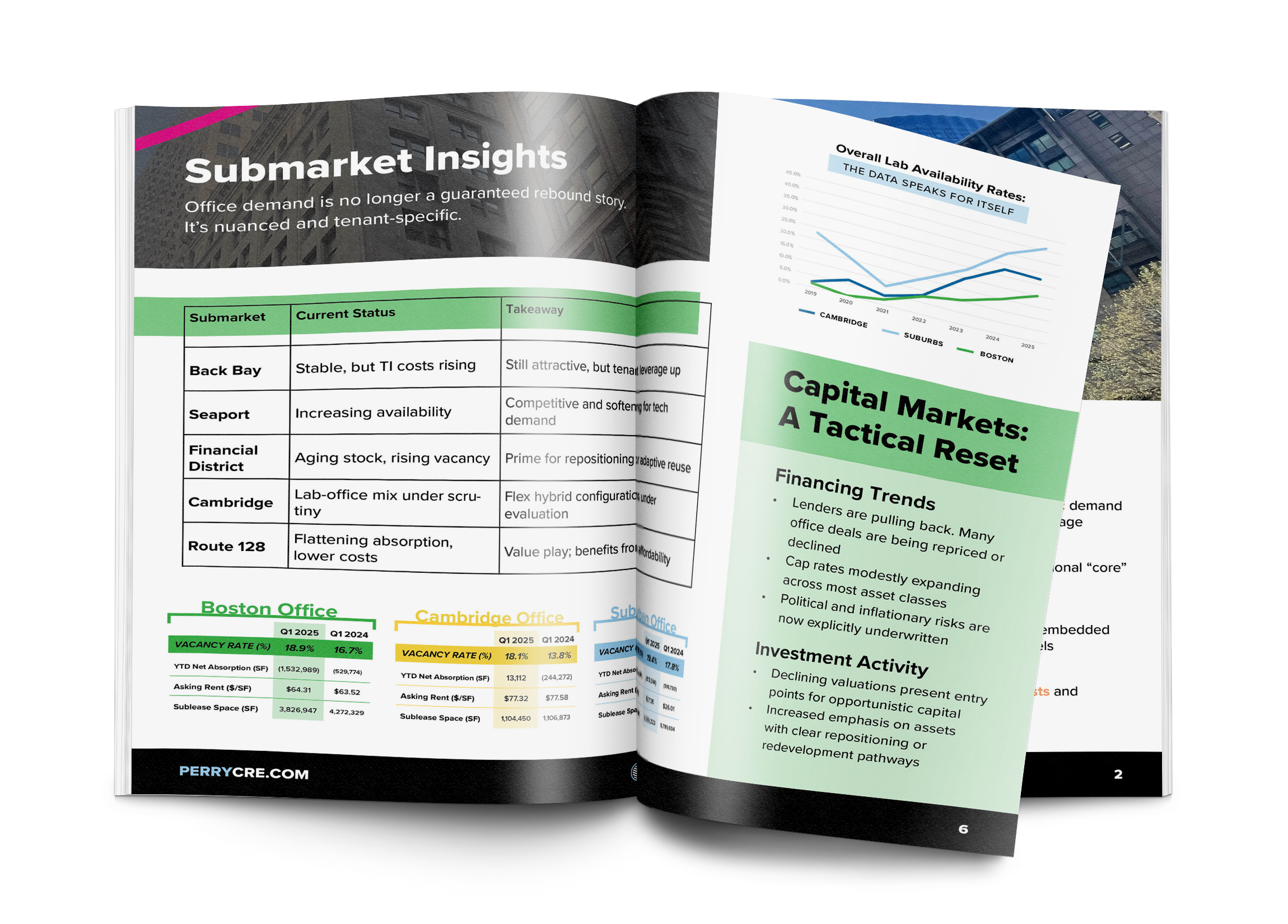The Perry Perspective.
Research + Quarterly Market Reports.
Q1 2025 Market Report.
WE’RE NO LONGER navigating traditional economic cycles. Today’s volatility stems from what Jamie Dimon called a “menu of tariffs,” which (whether or not it tips the U.S. into a full recession) will undoubtedly slow growth. More than numbers on a spreadsheet, these policies introduce a thousand unknowns: the retaliatory actions of other countries, the impact on corporate confidence and capital flows, and deep questions around the future of America’s economic alliances. Markets aren’t just jittery – they’re fundamentally disoriented.


Q4 2024
Market Report.
YEAR-END 2024 marks the 19th quarter since COVID fundamentally changed the way we work and do business. Few industries have felt this impact more acutely than commercial real estate.
Debates over the merits of remote versus in-person work are still a flashpoint. Industry leaders pack panel discussions – where words like “vibes,” “positive thinking” and “feelings” have replaced typical jargon like “deals” and “effective rent.”
Q3 2024 Market Report.
Writing this market report has been a challenge. We spent a significant portion of the third quarter poring over financial publications, press releases, press conferences, social media posts and too many ‘hot takes’ to count. Layer in a long-awaited cut in the federal funds rate, a Goldilocks jobs report and pair it all with a presidential election. The truth is that, economically speaking, there’s not much for us to say that hasn’t already been said.


Q2 2024
Market Report.
INVESTORS AND ECONOMISTS generally expect at least a quarter point cut in the federal funds rate by year-end. Although we cannot ignore the compounding effects of inflation, at Perry CRE, we are approaching the second half of 2024 with cautious optimism. While the labor market is still relatively strong, signs of macroeconomic cooling are beginning to emerge. Headline inflation growth fell 30 basis points (bps) between May and June, while the unemployment rate ticked up 10 bps to 4.1% in the same time frame.
Q1 2024 Market Report.
IF THE FED IS LOOKING for reasons to justify interest rate cuts this year, economic data isn’t helping. Non-farm payroll jumped by 303,000 – beating estimates by more than 50%, while unemployment ticked down to 3.8% from February to March. Inflation remains stubbornly high – especially in the service sector, which is more immune (though not impervious) to interest rates.


Q4 2023
Market Report.
SOLID PAYROLL GROWTH and slight declines in both inflation and the unemployment rate continue to reflect an economy still climbing out of the crater left by the pandemic – and following a tepid growth path. Seven million jobs have been created since January 2022 – a remarkable pace, but just a fraction of the 22 million jobs lost due to COVID. GDP growth averaged 1.8% over the last 4 years – compared to 2.4% average growth between 2014 and 2019. And while inflation has declined nominally, we are still 1.2 percentage points away from the Fed’s target.
Q3 2023
Market Report.
A CURSORY GLANCE at economic indicators reveals strong footing and the potential to achieve a soft landing. At 3.8%, the unemployment rate has been gradually increasing since April – suggesting a loosening labor market. However, unemployment is only 20 basis points (bps) higher than Q1 2022 – when the Federal Reserve (Fed) began raising interest rates.


Q2 2023
Market Report.
So far, there is no evidence of even a mild recession. Many market analysts (including this one) have spent the last two years looking for indicators to confirm the US economy was either in a recession or about to enter one. With inflation and hiring cooling, but wages rising and unemployment still declining, it is possible that the most anticipated economic event in recent history may not even happen.
Q1 2023
Market Report.
THE ECONOMY has been weird in recent years – few experts anticipated inflation would rise so significantly, interest rates would skyrocket or that the effect of rising rates would have so little effect on tamping down inflation. Unemployment filings (a proxy for layoffs) are ticking up, but overall unemployment figures (at 3.5% both state and nationwide) are well below equilibrium – meaning the labor market is still strong.
